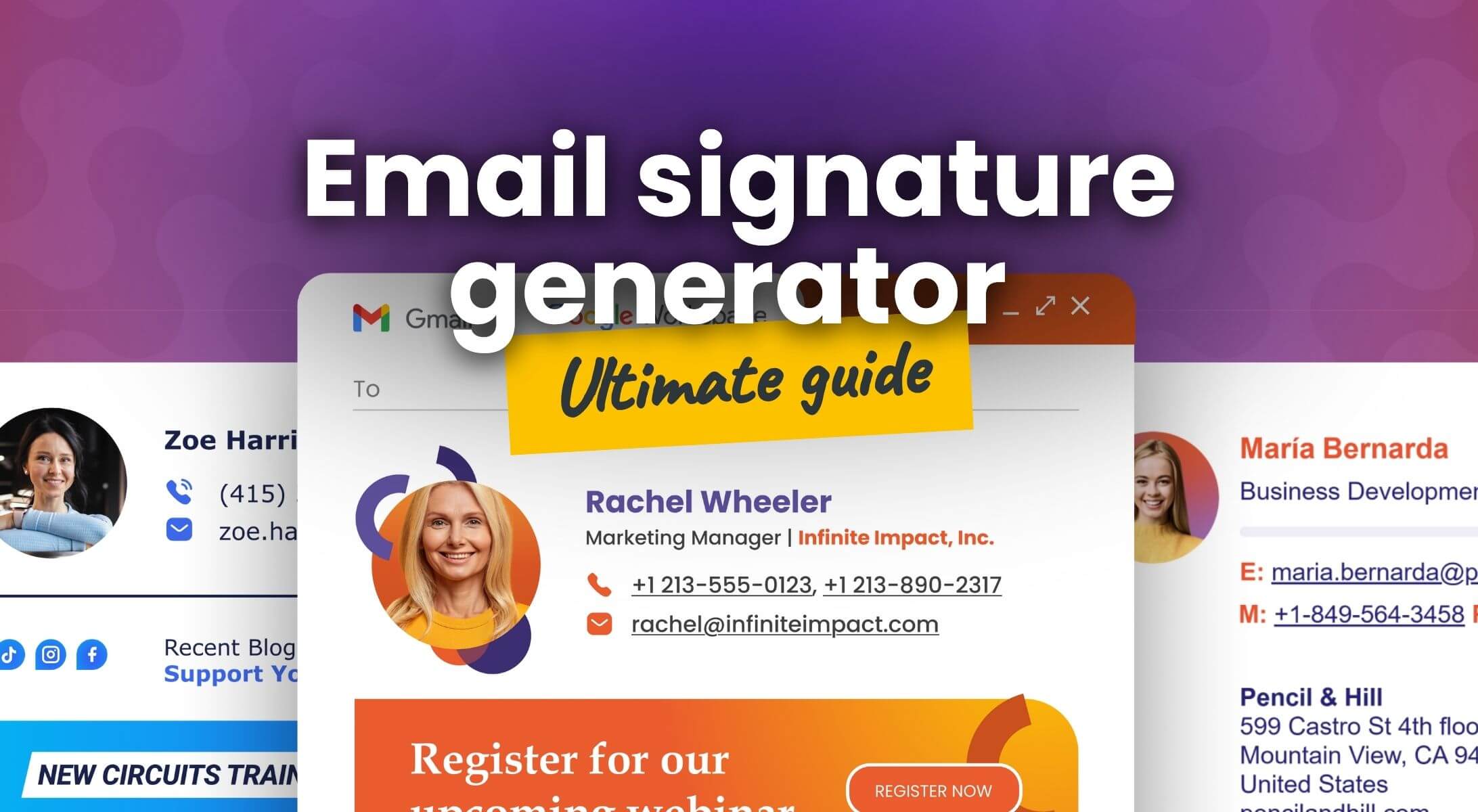An email signature generator is much more than just a design tool – it’s a strategic solution that simplifies how businesses and individuals create, manage, and deploy professional email signatures at scale. Instead of manually building and updating signatures for every team member, these generators provide streamlined, often automated workflows that ensure brand consistency, accurate information, and marketing-ready features like banners, clickable CTAs, and scheduling links. If you’re still thinking of email signatures as static contact footers, it’s time to upgrade your approach.
What Is an Email Signature Generator?
An email signature generator is a tool that helps you create professional, HTML-based signatures quickly and effortlessly – no coding required. It’s especially useful for maintaining brand consistency across all email communication.
Most tools offer features like:
- ✅ Ready-made templates to help you get started quickly
- ✅ Drag & drop editors – professional generators like SignatureSatori let you create a custom email signature. You can build your signature from scratch by placing and arranging individual elements such as your logo, profile photo, name, or buttons
- ✅ Support for branding components, including social media icons, CTA links, and custom banners
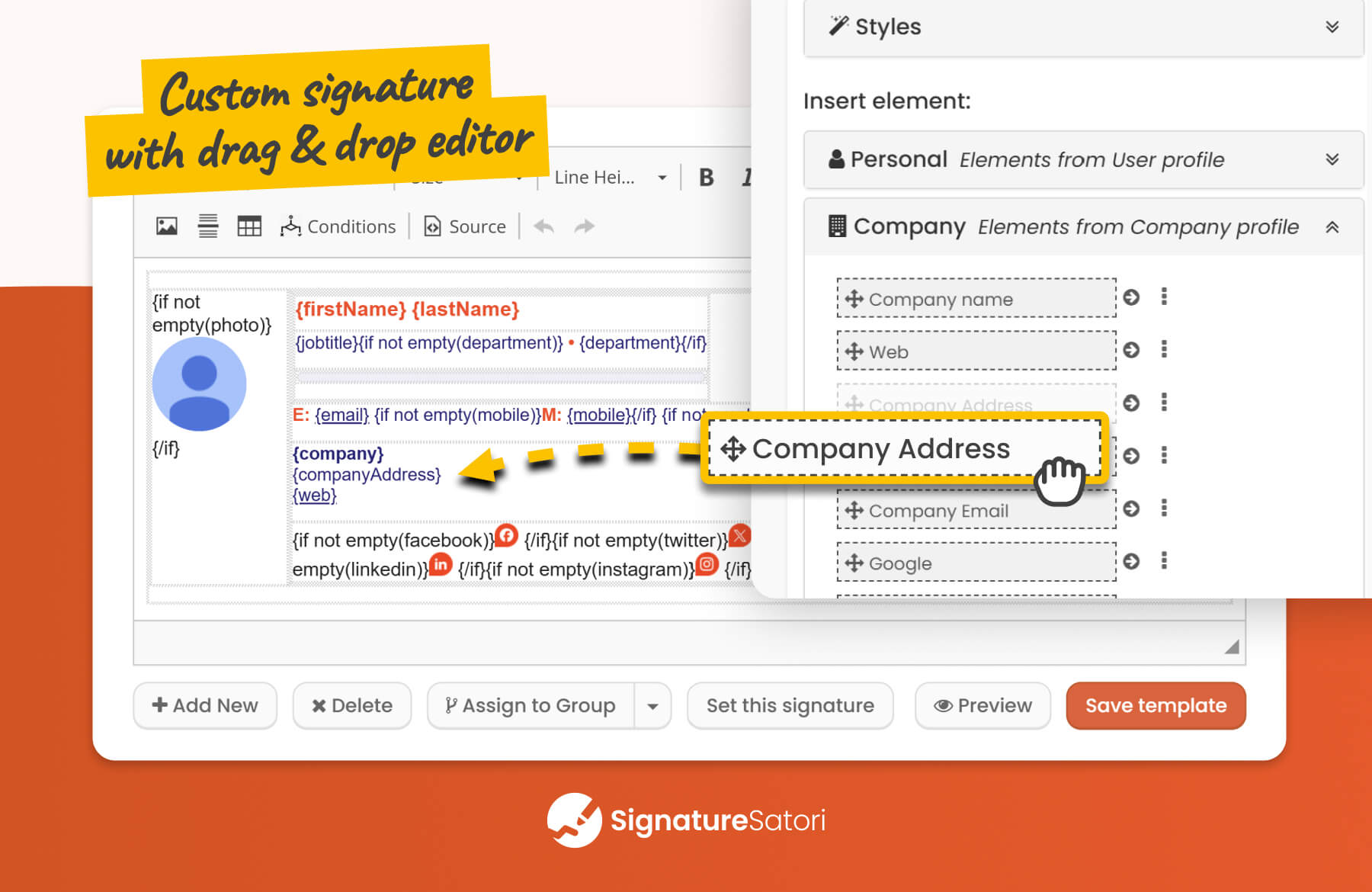
Most tools today are available as an online email signature generator, meaning they run in your browser without the need for desktop installation. However, business-level solutions that offer centralized management, ensuring consistent and up-to-date signatures across the entire organization, may require additional setup steps, such as installation from Google Workspace Marketplace or authorization with Microsoft 365 to enable full integration.
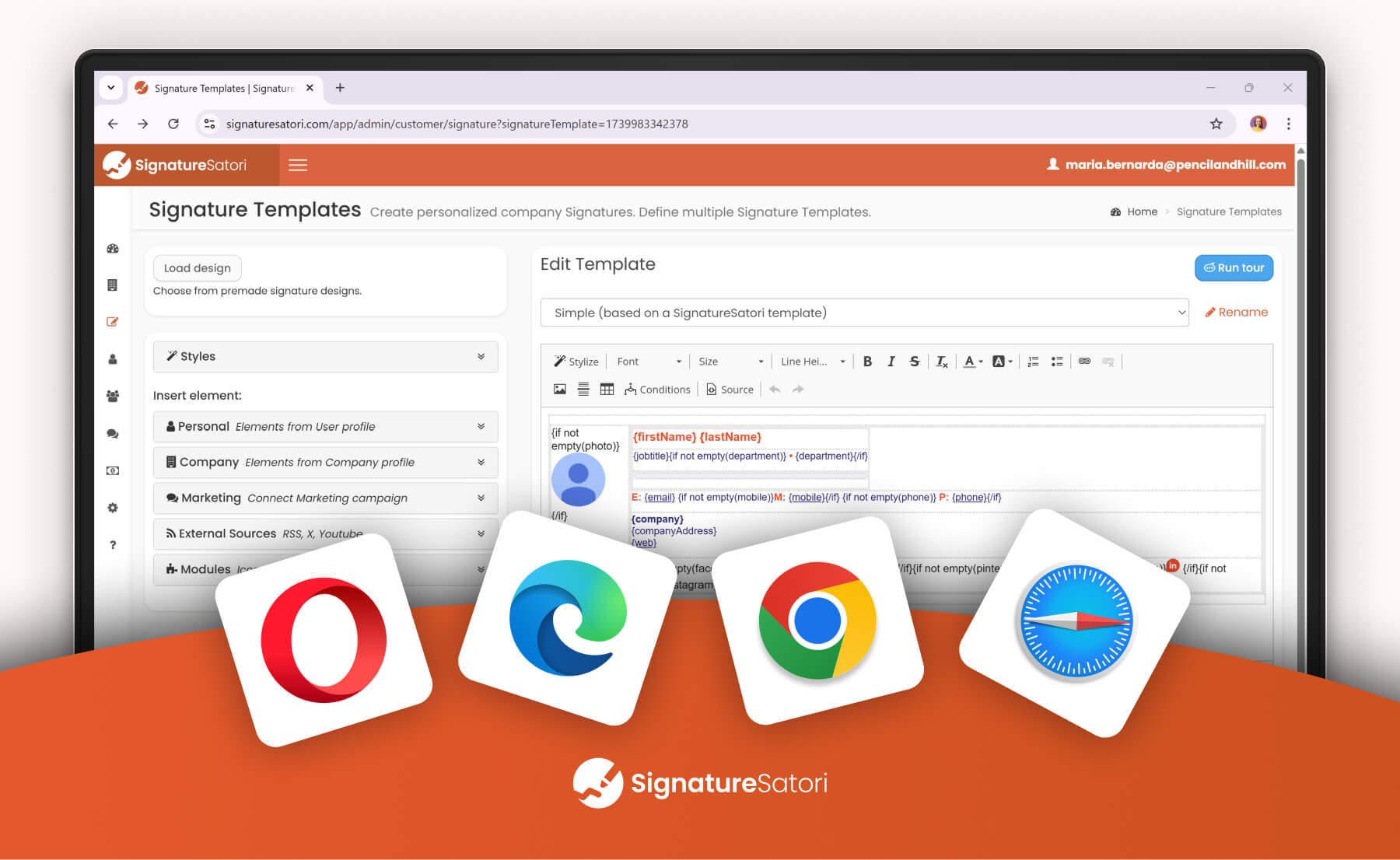
It’s important to note that an email signature generator is not the same as an e-signature tool used to legally sign documents. Similarly, an online signature is a broader term that can refer to any kind of signature created online, including an e-signature, a scanned handwritten signature, or even a stylized image made using a script font.
In contrast, an email signature refers to the block of contact and branding information that appears automatically at the bottom of your emails. So when people search for an email signature generator, they almost always mean a tool that creates HTML-based email signatures – exactly the kind we’ll explore in the next sections.
The Best Email Signature Generator Is HTML Email Signature Generator
Most modern email signature generators work by constructing the signature using HTML (HyperText Markup Language) behind the scenes, even if the user interacts with a simple visual editor. This HTML foundation is what allows for rich formatting, images, structured layouts, and, importantly, clickable elements, moving beyond plain text limitations.
Here’s an example of a clickable email signature built with an HTML generator – feel free to click the links or icons.
In our opinion, this is the best way to create and manage your email signature. For a deeper dive into the benefits of HTML-based signatures, read our guide dedicated to HTML email signature generators.
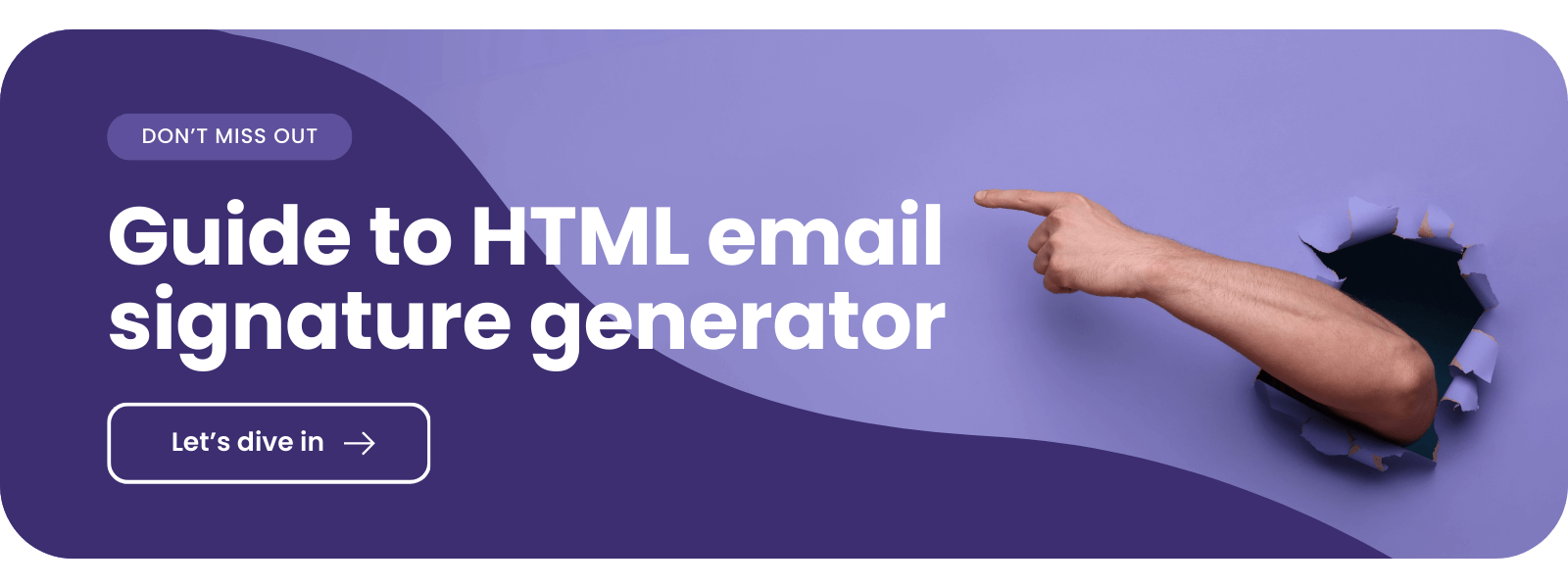
Personal Email Signature Generator vs. Business Email Signature Generator
The needs and features differ significantly between generators designed for individual use versus those built for organizations:
Personal Email Signature Generators
- Focus: Mostly on individual branding and professionalism. Think of it like a personalized keychain; it’s a tool designed to turn a standard digital presence into something uniquely and recognizably yours.
- Features: Typically offer template libraries, basic customization (text, logo maker, headshot upload), social media links, and manual copy-paste installation. Free versions are common and suitable for freelancers or individuals with basic needs.
- Goal: To create a single, polished signature that enhances personal credibility and provides essential contact information.
Common scenarios where personal generators make sense:
- ➡️ A freelancer: Eva is a freelance copywriter who uses a Gmail account for client communication. She uses a free personal email signature generator to add her name, role, contact info, portfolio link, and LinkedIn profile to each message.
- ➡️ A student looking for an internship: Liam is applying for internships and wants to appear professional. He uses a simple signature generator to include his name, university, and contact info in his emails from a personal Gmail account.
- ➡️ Owner of a blog or a personal project: Sophie runs a food blog and uses a signature with a logo, website link, and Instagram profile in her personal emails to partners and readers.
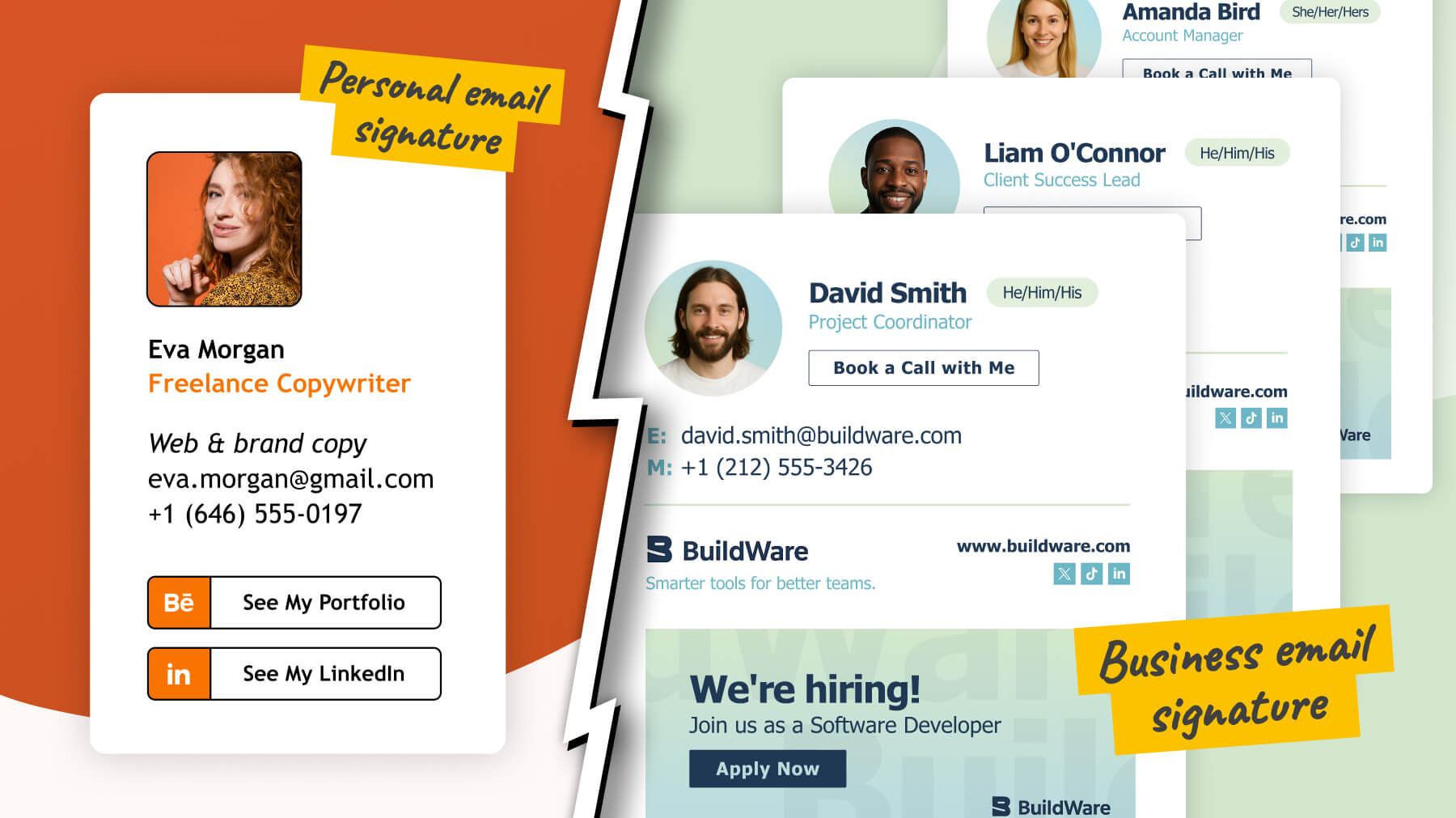
Business Email Signature Generators
- Focus: Centralized management, brand consistency, marketing integration, and efficiency across an entire organization.
- Features: Include centralized dashboards, advanced template management, dynamic content insertion synced from company directories (like Microsoft 365 or Google Workspace), banner campaign management, detailed analytics, user permissions, automated deployment options, and robust customer support. These are typically paid solutions with per-user pricing models.
- Goal: To ensure every employee email aligns with corporate branding, maintains big data accuracy, leverages signatures for marketing campaigns, ensures legal compliance with disclaimers, and streamlines administration for IT and marketing teams.
Common scenarios where business generators make sense:
- ➡️ A startup with 6 employees: Martin’s tech startup has 6 team members using @companyname.com email addresses. He sets up a business email signature generator to ensure everyone uses the same logo, colors, and company-wide banner promoting their latest product.
- ➡️ A corporation with legal requirements: A large law firm uses a business signature generator integrated with Google Workspace. It automatically adds a disclaimer to every outgoing email and updates job titles based on HR data.
- ➡️ A marketing agency specializing in campaigns: Each quarter, a digital agency updates the promotional banner in their employees’ email signatures to reflect current campaigns – managed centrally through their signature platform.
- ➡️ An international company with a remote team: A remote-first company with employees across Europe and Asia uses centralized signature management to localize language, maintain brand consistency, and streamline onboarding.
The choice depends on scale and required features. While individuals can achieve a professional look with free or basic tools, businesses benefit significantly from the control, automation, and marketing capabilities offered by paid, team-focused solutions.
Important note – personal generators are typically used with personal email accounts (e.g., @gmail.com), while business generators are tied to a company domain (e.g., @company.com). For example, SignatureSatori is exclusively a business email signature generator.
AI Is Everywhere in 2025 – But What About the AI Email Signature Generator?
With artificial intelligence transforming everything from writing tools to graphic design, it’s no surprise that signature generators are starting to adopt AI as well. But how much of it is just hype, and what can these tools really do?
AI email signature generators don’t yet form a separate category. Instead, we’re seeing individual AI-powered features being integrated into traditional HTML generators.
Some of the most common examples include:
- 🗣️ Voice or text-based editing – you can type or say a command like ‘Move the logo below the profile picture’ and let the layout adjust automatically. (See example below.)
- 🎨 Automatic style matching – for example, pulling your brand color from the logo and applying it across the whole signature
- ✍️ Text suggestions – like generating a call-to-action phrase or short tagline.
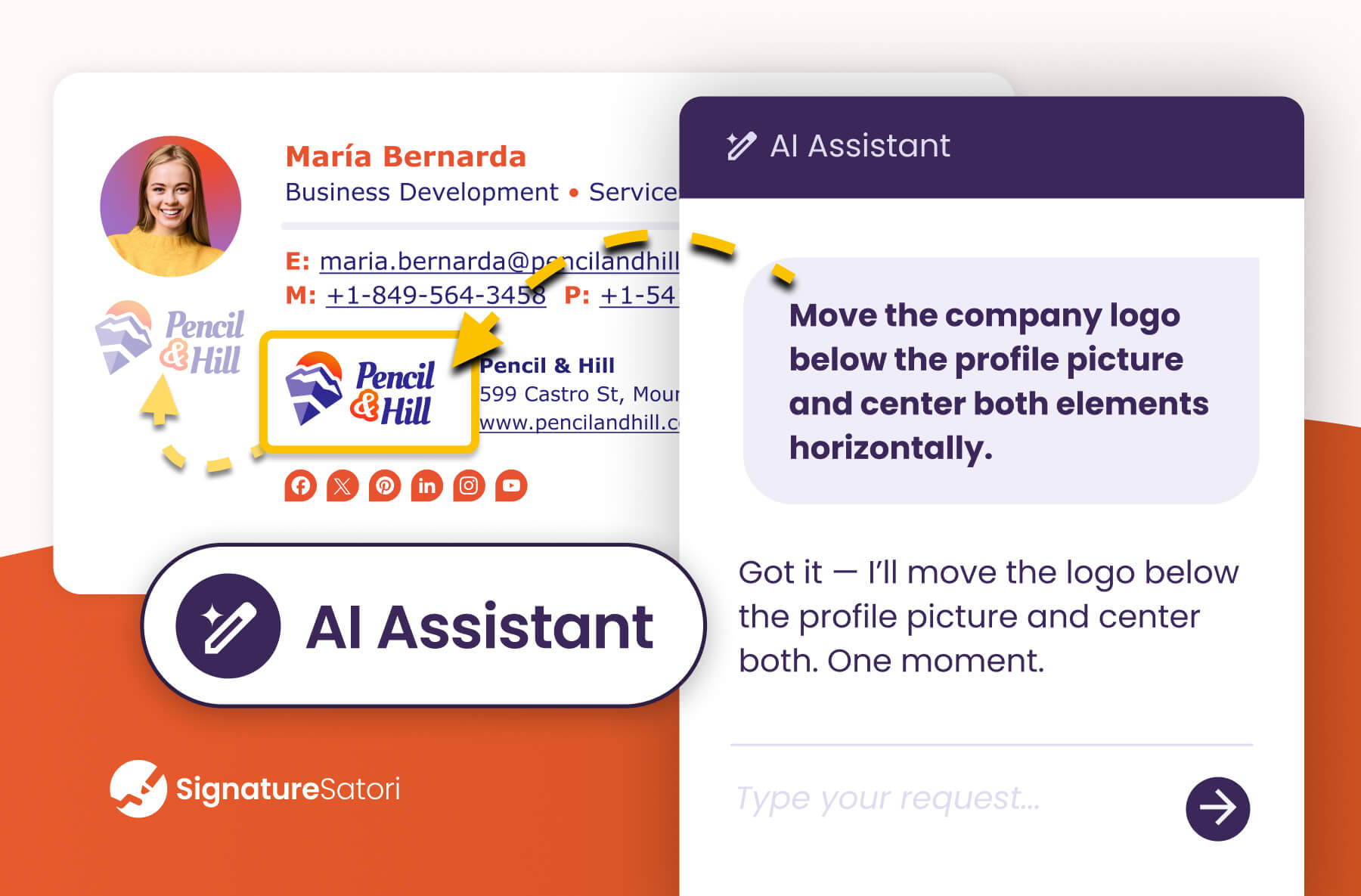
However, this field is still evolving. Only a few signature generators currently offer AI features, and even those are fairly limited in scope. That said, the pace of development is fast, and we can expect AI-powered capabilities to become a standard part of modern signature tools very soon.
Choosing the Right Email Signature Generator for Gmail, Outlook, and Other Platforms
Not every email signature generator works the same way across different email clients. In fact, they usually fall into one of three categories — and understanding the difference can save you time and frustration.
A) Platform-Specific Generators
Some tools are purpose-built for a single environment, like Gmail or Outlook. These are typically able to offer deep integration, including automatic deployment, real-time updates, and syncing of user data from directory services like Google Workspace or Microsoft 365.
For example, SignatureSatori is an email signature generator for Gmail that connects directly to Google Workspace. This kind of tight integration means you don’t have to manually copy or install anything — signatures are updated centrally and applied instantly across the team.
B) Multi-Platform Generators
These tools support multiple clients, such as Gmail, Outlook, and Apple Mail, and are designed to offer consistent branding across platforms. Some offer native integrations with more than one environment, while others use hybrid approaches like browser extensions or desktop apps to enable centralized updates.
However, with this versatility often comes compromise. Compared to platform-specific tools, multi-platform generators may lack advanced features tied to a particular ecosystem, like per-user targeting, signature previews in native clients, or dynamic campaign management.
C) Universal Generators
These are usually marketed as “works everywhere” solutions. Technically, they do — because they generate HTML code that can be pasted into any email client. But that also means there’s no real integration. Each user has to insert and update their signature manually, which can be error-prone and time-consuming in larger teams.
This type of tool can be great for individuals or freelancers, but for companies managing dozens or hundreds of users, the lack of automation is a clear limitation.
So, Before Choosing Your Email Signature Generator, Ask Yourself:
Do you need deep automation and centralized control, or is manual setup enough for your use case? The answer will point you to the right type of solution.
There’s also another — and often overlooked — way to think about email signature generators and email clients: not from the sender’s perspective, but from the recipient’s. Different email apps (like Outlook, Gmail, or Apple Mail) display HTML differently. Even a signature that looks perfect in your own inbox may appear broken, misaligned, or incomplete to someone else, especially if the code behind it isn’t clean or optimized.
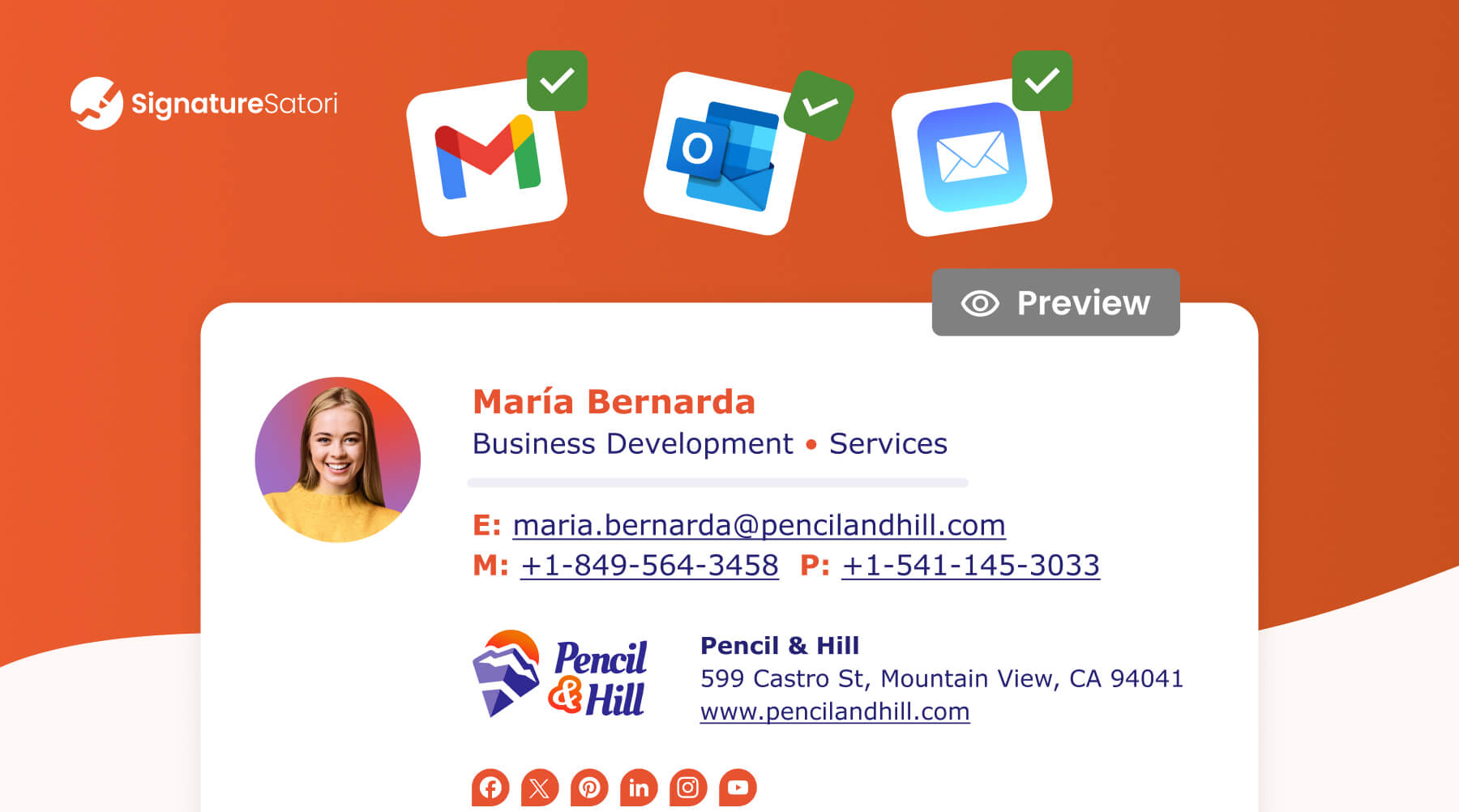
That’s why it’s important to choose a high-quality email signature generator with a solid reputation. A reliable tool ensures your signature displays consistently and professionally across platforms — no matter which email client your recipient is using.
Conclution
In summary, using a signature generator for email is key to achieving professionalism, consistent branding, and marketing goals. Selecting the right tool, considering features and platform compatibility, allows you to leverage this low-cost, high-impact channel effectively.
FAQ
How do I create a professional email signature for my business?
To create a professional email signature for your business, use a signature generator that supports HTML and branding. Include key details like your name, title, company, logo, and contact info, ensuring the design matches your brand and works on mobile. For team consistency, use a business email signature generator, like SignatureSatori.
Can I use a mobile email signature generator to create a mobile signature?
Unfortunately, a mobile email signature generator doesn’t exist yet. All signature generators are primarily designed for desktop use. If you use Gmail for your email signature and your Gmail mobile app is set up correctly, your desktop email signature will automatically appear in your mobile emails as well. To ensure that a signature appears in the email, simply follow the steps of this article about ‘How to set up a Gmail mobile signature on Android & iPhone.’
Are email signature generators safe to use?
Yes, reputable email signature generators are generally safe. If you’re only generating a personal signature and not granting the tool access to your company data, the risk is minimal. However, if you’re using such tools to manage signatures across an entire organization, especially when granting access to user data or email flow, greater caution is needed. In these cases, there are two main types of solutions to consider:
1. Server-side solutions, which route emails through external servers and insert signatures after sending. These can offer more features, but at the cost of increased security risks. If the external server experiences issues, emails may be delayed or may not be sent at all. That’s why it’s essential to thoroughly assess the provider’s security standards and reliability.
2. Client-side integrations, such as SignatureSatori, insert the signature directly into the user’s email before sending (e.g., using the Gmail API). These solutions don’t alter the email delivery path, making them generally safer and more suitable for organizations prioritizing data security.
Whichever option you choose, always look for providers with transparent data handling, secure infrastructure, and certifications like ISO 27001.
Do I need technical skills to use an email signature generator?
No, technical skills usually aren’t required. Generators use user-friendly visual editors and templates, often with a drag-and-drop interface. In addition, some generators (like SignatureSatori) allow you to access and edit the HTML code, which is mainly useful for developers or advanced users who want full control. For most users, the visual editor is more than enough.
What’s the difference between email signature generator / creator / maker / builder?
These terms are essentially the same. They all refer to tools that help you easily build an email signature without needing to write any code yourself.
